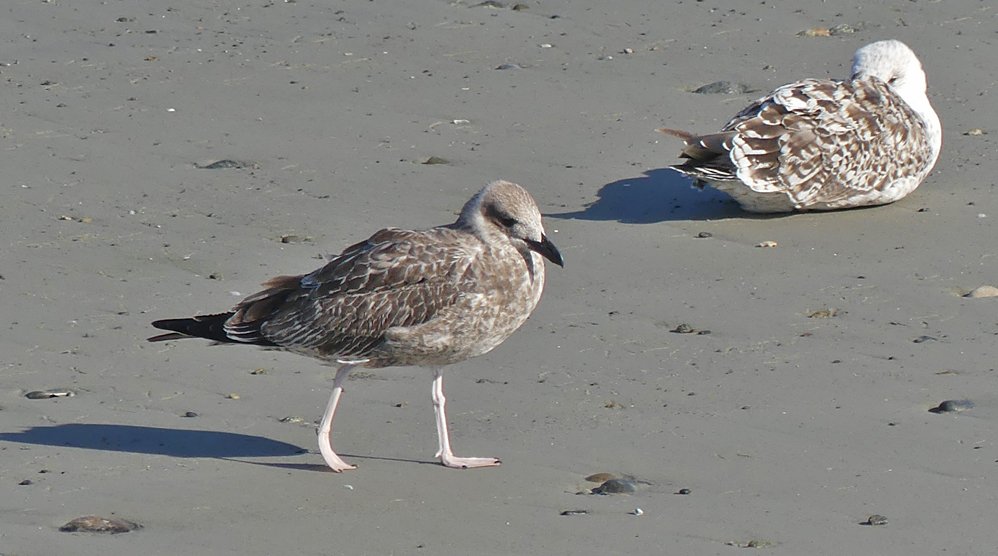August 2022
/Autumn bird migration picked up a little at the start of August with a returning Wheatear at Fort Hommet on 5th and a Green Sandpiper at Grand Pre plus 2 Greenshanks at Vale Pond on 8th. Other than that, the only bird of interest was actually a patch tick for me, with a Little Tern at Port Soif on 12th. This was highly unsatisfactory though since it was a brief sighting from the car as I drove past and was unable to stop (not found by me btw, I knew it was there!). Nevertheless, a new bird for the Hommet-Rousse patch list.
Green Sandpiper - Grand Pre, 8 Aug 22
Low water levels at the pond at Grand Pre
Water Fern - Grand Pre, 8 Aug 22 - the very low water levels at Grand Pre meant that I was able to explore some areas that are usually underwater - the above species was a new plant for me, not very welcome in the nature reserve.
One area of interest (if you like that kind of thing) that can be done in August is look for Yellow-legged Gulls on the beaches. The adults are pretty straight forward but the juveniles are more tricky. The main thing to remember is that these have travelled here from southern Europe and so were born a month or so earlier than the local Herring and LBB Gulls. This means that the sunny summer weather will have taken its toll on their juvenile feathers and so the brown colour is usually paler and scruffier than the local youngsters. This is a good way of picking out some probables and you can then focus on some finer points.
Looking at the bird below, you can see the paleness of the brown colour of the feathers, with narrow less-crisp pale edges. The main feathers to focus on are the tertials (the large brown feathers before and above the dark wing tips) which are usually finely edged pale with no notches, a bit of a paler smudge near the tip and obviously worn and battered, often wavy edged due to wear. Also below one on the mantle feathers has been replaced by a new grey-splodged feather - it is too early for a Herring/LBB to show this. The bill is generally dark and thick and the head is pretty whitish. These are the main features to look for in a Yellow-legged and I picked out 5 birds in just a smallish gull flock on Perelle beach on 10th August. I am no expert on immature gulls but I’m getting more knowledgeable year-on-year.
Yellow-legged Gull - Perelle, 10 Aug 22
Yellow-legged Gulls - Perelle, 10 Aug 22 - right hand bird pretty standard, left hand less obvious but probably still is one.
Yellow-legged Gull - Perelle, 10 Aug 22 - another bird, even from distance they can sometimes be quite distinct.
Seagull - Perelle, 10 Aug 22 - some birds cause confusion - this is a very dark bird but shows many features of yellow-legged, and i feel that it probably is one - also, the large gulls do hybridise sometimes so unclear birds may just have unclear genes.
I had too much happening for much moth trapping in the first half of August, the best night being 11th Aug when I had a few immigrant micros such as Cydia amplana, Onocera semirubella and Nephopterix angustella.
Something new that I did focus on was Diptera or flies (other than hoverflies which I have been looking at for a while). I have always been a little wary about delving into flies as there seemed a huge amount of species and so many different families, with so many looking more or less the same. Also I didn’t feel that I had enough books to make positive ID and I found using the fly family key a little confusing. However, when you focus and read more you soon see that they are doable, especially nowadays that you can find so many keys online which can be used. I had plenty of specimens to look at and I managed to work through them all finding a few new species for Guernsey in the process.
Flies from many different families
Locust Blowfly Stomorhina lunata - Baubigny, 5 Aug 22 - a good fly to find, this species is a southern species which parasitises Locusts in southern Europe and North Africa. It is a traditionally a very rare visitor, but appears to be expanding its range further north so may be now using other grasshopper species as hosts.
Mantis Fly Ochthera mantis - Grand Pre, 8 Aug 22 - found this crazy-legged species on the bare mud at Grand Pre - a new species for Guernsey I believe.
Aulagromyza populicola - Grand Pre, 8 Aug 22 - another new species for Guernsey, the larva mining Poplar leaves.
Sarcophaga caerulescens - Baubigny, 5 Aug 22 - some species of fly are tricky to identify without looking at the genitalia - so here is a male flesh fly’s provate parts - you’re welcome.
Close Encounters of the fly kind













